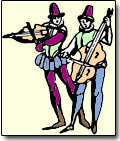 The fifteenth century saw a rise in the popularity of the gamba family of instruments. The viol da gamba (gamba being Italian for leg) was held when seated like a cello between the legs. The viola da braccia was held on the arm. Both of them had "frets", rather like the guitar, which allowed the player to produce accurate notes. The fifteenth century saw a rise in the popularity of the gamba family of instruments. The viol da gamba (gamba being Italian for leg) was held when seated like a cello between the legs. The viola da braccia was held on the arm. Both of them had "frets", rather like the guitar, which allowed the player to produce accurate notes.
These early forerunners of the violin are still produced by specialist historical instrument makers, and there is great interest in playing the music which was popular at that time. The music of this period had a very "pure" quality as the notes were so precise, and the technique of playing these instruments was quite different from the modern way of playing.
Later, the viola da braccia was held under the chin, lost its frets had a make over in style and construction and emerged into a modern-day violin. |

